Plant lovers across the globe are drawn to species that have stood the test of time—each one telling a story, carrying cultural significance, or simply dazzling with its beauty. From the elegant rose to the resilient cactus, these iconic varieties aren’t just decorative—they’re symbols of history, healing, and tradition. But what makes a plant truly famous, and how can you give it the care it deserves?
Whether you’re a seasoned green thumb or just getting started, understanding famous plant care tips is essential. While each species has its quirks, they all share one thing in common: the need for thoughtful attention. This guide highlights ten of the world’s most celebrated plants, offering practical advice to help them thrive in your garden, balcony, or living room.
Before diving into the individual care instructions, we’ll first walk through a few universal practices that form the backbone of healthy plant care—from choosing the right soil to preventing common pests. With the right knowledge, these legendary plants can flourish in any home.
Table of Contents
General Plant Care Principles
Caring for any plant begins with mastering the basics. Whether you’re growing a vibrant sunflower or a delicate orchid, these foundational tips will help you create the right environment for healthy, long-lasting growth. While each species may have its specific requirements, these principles apply across nearly every type of plant.
Soil Quality Matters
Good soil is more than just dirt—it’s a living medium that supports plant roots with nutrients, moisture, and oxygen. Most plants prefer well-draining soil that retains some moisture without becoming soggy.
- Tip: Mix in compost or aged manure to improve soil structure and add essential nutrients.
- Avoid heavy clay that traps water or sandy soil that drains too quickly without holding moisture.
Watering Wisely
Overwatering is one of the most common mistakes gardeners make. Plants need water, but they also need to breathe. If the soil stays constantly wet, roots can suffocate and rot.
- Always check the soil about an inch deep before watering.
- Water slowly and deeply to encourage strong root systems.
- Adjust frequency based on the season, plant type, and whether you’re using pots or garden beds.
Light and Placement
Light is food for plants. Most flowering plants, especially the famous ones, thrive in full sun—but not all light is created equal.
- Full sun means six or more hours of direct sunlight per day.
- Partial shade may suit more delicate plants like orchids or ferns.
- Indoors, place your plants near a bright window and rotate them regularly to prevent uneven growth.
Fertilization for Strength
Fertilizers replenish nutrients that may be missing from your soil, especially in containers or during heavy blooming periods. But more isn’t always better.
- Use balanced fertilizers (e.g., 10-10-10) unless a plant has specific needs.
- Follow label instructions carefully to avoid overfeeding, which can burn roots or trigger weak, leggy growth.
- Slow-release granules are a good choice for beginners.
Pests and Disease Prevention
Even the healthiest plant can encounter pests or fungi. Prevention is easier than cure.
- Keep foliage dry and maintain airflow between plants.
- Check for signs of common pests like aphids, spider mites, and mealybugs.
- If needed, use natural treatments like neem oil or insecticidal soap.
By mastering these essentials, you’re setting the stage for success with even the most finicky or exotic plant. Up next, we’ll walk through ten globally renowned plants—each with its own character, challenges, and rewards.
Roses
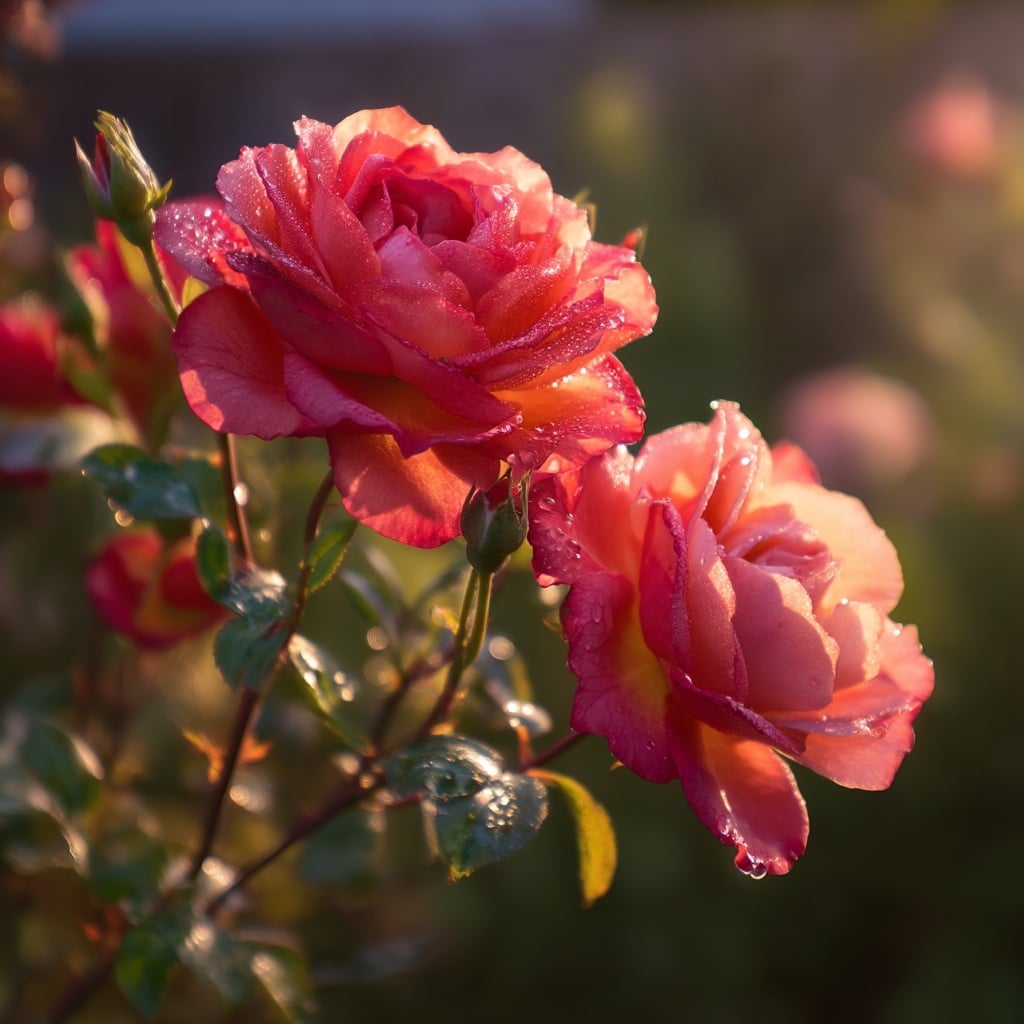
No plant evokes romance and timeless beauty quite like the rose. Revered for centuries across cultures and continents, roses are more than just a floral symbol—they’re a horticultural classic. With thousands of varieties in every shape, size, and color, roses continue to be one of the most beloved plants in gardens around the world.
Background and Significance
The rose has long symbolized love, passion, and purity. Ancient civilizations—from the Greeks to the Persians—used roses in everything from ceremonies to perfumes. In modern times, roses remain a top choice for both formal landscapes and personal flower beds, thanks to their unmatched elegance and diversity.
How to Care for Roses
Roses might have a reputation for being high-maintenance, but with the right approach, they’re incredibly rewarding.
🌤️ Sunlight Requirements
- Roses crave sunlight. Aim for 6 to 8 hours of direct sunlight each day.
- Morning sun is ideal, as it helps dry off dew and prevent fungal issues.
🌱 Soil and Planting Needs
- Choose slightly acidic soil (pH 6.0–6.5) that’s rich in organic matter.
- Drainage is critical—if your soil holds too much water, amend it with compost or use raised beds.
💧 Watering Tips
- Water deeply about once or twice a week, depending on the weather.
- Always water at the base—wet leaves are prone to black spot and mildew.
- Mulching helps retain moisture and suppress weeds.
🌿 Fertilization Schedule
- Feed your roses with a balanced fertilizer in early spring and again midseason.
- Avoid feeding late in the year to prevent tender new growth before frost.
✂️ Pruning Techniques
- Prune in late winter or early spring, just as buds begin to swell.
- Remove dead, diseased, or weak stems to promote air circulation.
- Cut just above an outward-facing bud at a 45-degree angle.
🐛 Common Pests and Problems
- Aphids and black spot are the most common issues.
- Encourage airflow, avoid overhead watering, and use neem oil or insecticidal soap as needed.
- Inspect your roses weekly to catch problems early.
Why They’re Famous
Few plants have had the cultural and historical impact of the rose. From Shakespeare’s sonnets to royal emblems, the rose’s legacy is rooted in both myth and memory. It’s a classic choice for gardeners seeking both beauty and meaning in their landscape.
Orchids
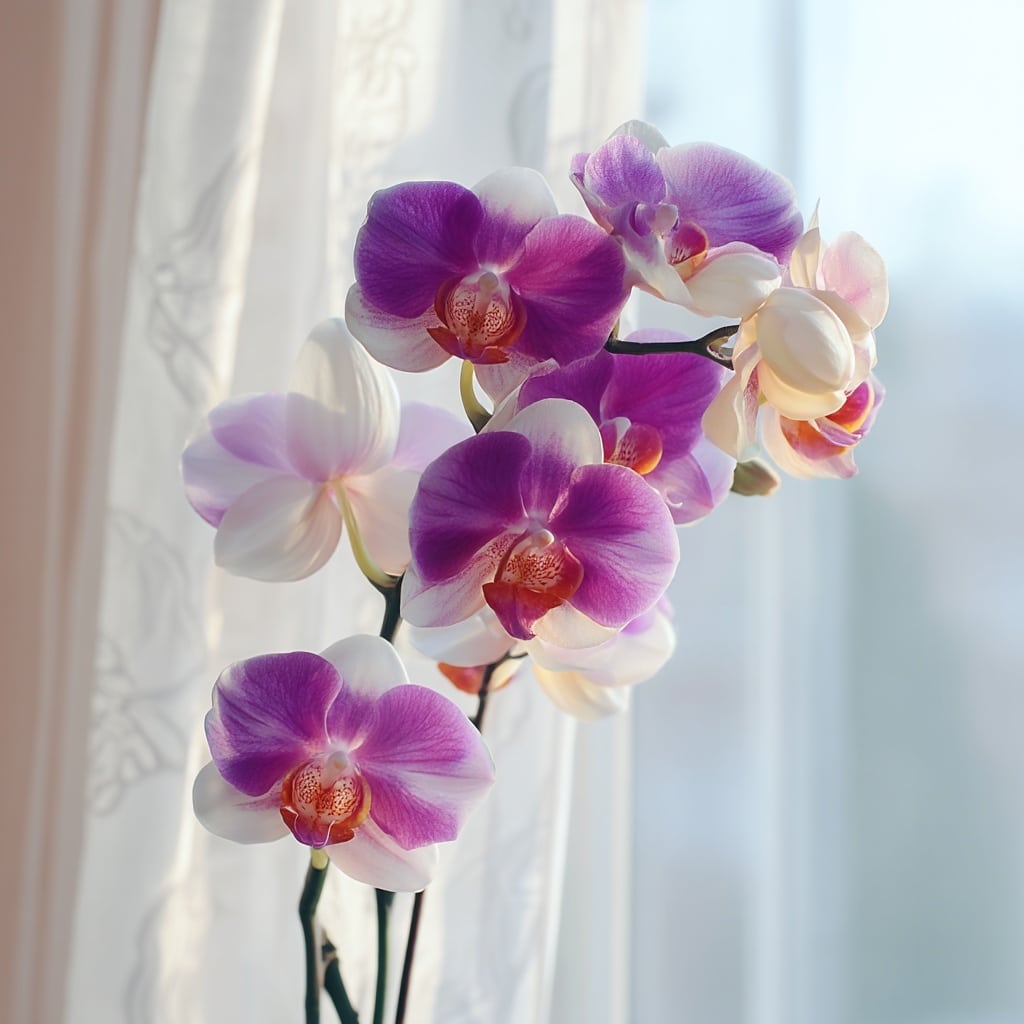
Among the most exotic and elegant flowers in the plant kingdom, orchids have captured the admiration of gardeners and collectors for centuries. Their intricate blooms and vast range of colors make them a striking addition to any home or greenhouse. Despite their reputation for being finicky, many orchids can thrive with the right conditions and a bit of patience.
Background and Significance
With over 28,000 species and even more hybrids, orchids form one of the largest and most diverse families in the plant world. In cultures from Asia to South America, orchids symbolize refinement, beauty, and luxury. They’re often gifted as a token of admiration or celebration and have long been cultivated for their ornamental value.
How to Care for Orchids
Don’t let their delicate looks fool you—many orchids are surprisingly resilient when grown with proper care.
🌤️ Light Requirements
- Most orchids prefer bright, indirect light.
- Harsh sun can scorch their leaves, while too little light prevents blooming.
- East- or north-facing windows are ideal indoors.
💧 Watering and Humidity
- Water about once a week, allowing the potting medium to dry slightly between waterings.
- Avoid letting water sit in the crown of the plant—it can cause rot.
- Orchids love humidity—aim for 50–70%. Use a tray of pebbles and water or a humidifier if needed.
🌱 Potting Medium and Repotting
- Never use standard potting soil. Orchids need a bark-based orchid mix with ingredients like perlite or sphagnum moss.
- Repot every 1–2 years, especially when roots outgrow the container or the medium breaks down.
🌡️ Temperature and Air Circulation
- Ideal temperatures range from 65–80°F (18–27°C) during the day with a slight drop at night.
- Keep orchids away from cold drafts and heat vents.
- Gentle airflow helps prevent fungal issues—avoid stagnant corners.
🌿 Fertilization
- Use a diluted, balanced orchid fertilizer (20-20-20 or similar) every 2–4 weeks during the growing season.
- Cut back on feeding when the plant is dormant.
🌸 Encouraging Reblooming
- After flowers drop, trim the flower spike just above a node to encourage a possible new bloom.
- Be patient—some orchids take months to rebloom.
Why They’re Famous
Orchids are prized for their extraordinary variety, symmetry, and elegance. Once a symbol of rare luxury, they’re now widely available but no less captivating. Their long-lasting blooms and graceful presence continue to make orchids one of the most popular houseplants in the world.
Tulips
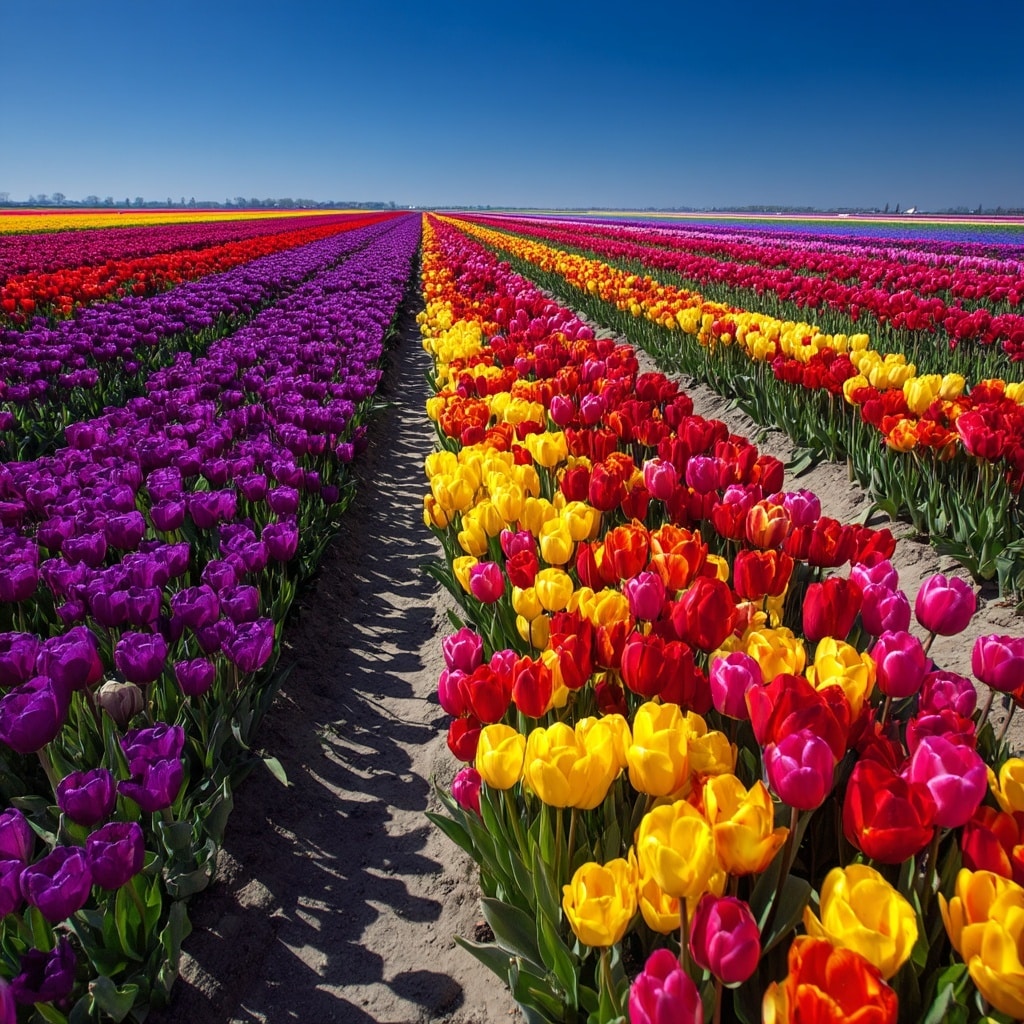
Graceful and colorful, tulips are the heralds of spring. Their perfectly cupped blooms and vivid hues have made them a staple in gardens and floral arrangements for centuries. Despite their simple appearance, tulips are steeped in history and remain a favorite for gardeners looking to make a bold, seasonal statement.
Background and Significance
Originating in Central Asia, tulips rose to fame during the 17th-century Dutch “Tulip Mania”, a period when single bulbs were traded for extraordinary sums. Today, the Netherlands remains synonymous with tulips, but their charm has spread globally. They’re now grown in gardens, containers, and public parks across the world—celebrated for their symmetry and rich palette
How to Care for Tulips
Tulips are easy to grow, provided you give them the right start. Timing and soil conditions are key to strong, vibrant blooms.
🌱 Planting the Bulbs
- Plant in autumn, around 6–8 weeks before the first hard frost.
- Choose a sunny location and plant bulbs about 6–8 inches deep, pointy end up.
- Space them 3–5 inches apart to allow room for growth.
🪨 Soil and Drainage
- Tulips need well-draining soil to prevent bulb rot.
- A sandy loam with a slightly acidic to neutral pH (6.0–7.0) is ideal.
- If your soil is heavy, add compost or grit to improve drainage.
💧 Watering Needs
- Water the bulbs thoroughly after planting.
- During spring, natural rainfall usually suffices—avoid overwatering, which can rot the bulbs.
- Let the soil dry slightly between waterings.
🌤️ Light and Temperature
- Tulips thrive in full sun, needing at least 6 hours of light daily.
- They require a cold dormancy period (35–50°F or 2–10°C) for 12–16 weeks to bloom properly.
- This makes them ideal for planting in cooler climates or in chilled containers.
🪻 Post-Bloom Care
- After flowering, allow the foliage to die back naturally—this helps feed the bulb for next year.
- Remove faded flowers to stop seed formation and conserve energy.
- You can lift and store the bulbs once the leaves turn yellow, especially in warm climates.
🐭 Common Issues
- Tulip bulbs are attractive to rodents—use wire mesh or repellents if needed.
- Fungal diseases like Botrytis can strike in damp conditions, so avoid overhead watering and provide airflow.
Why They’re Famous
Tulips are more than just spring favorites—they’re historical icons. Once worth more than gold, tulips transformed from luxury commodities to cheerful emblems of renewal. Their timeless beauty and relative ease of care have earned them a place in gardens large and small around the world.
Sunflowers
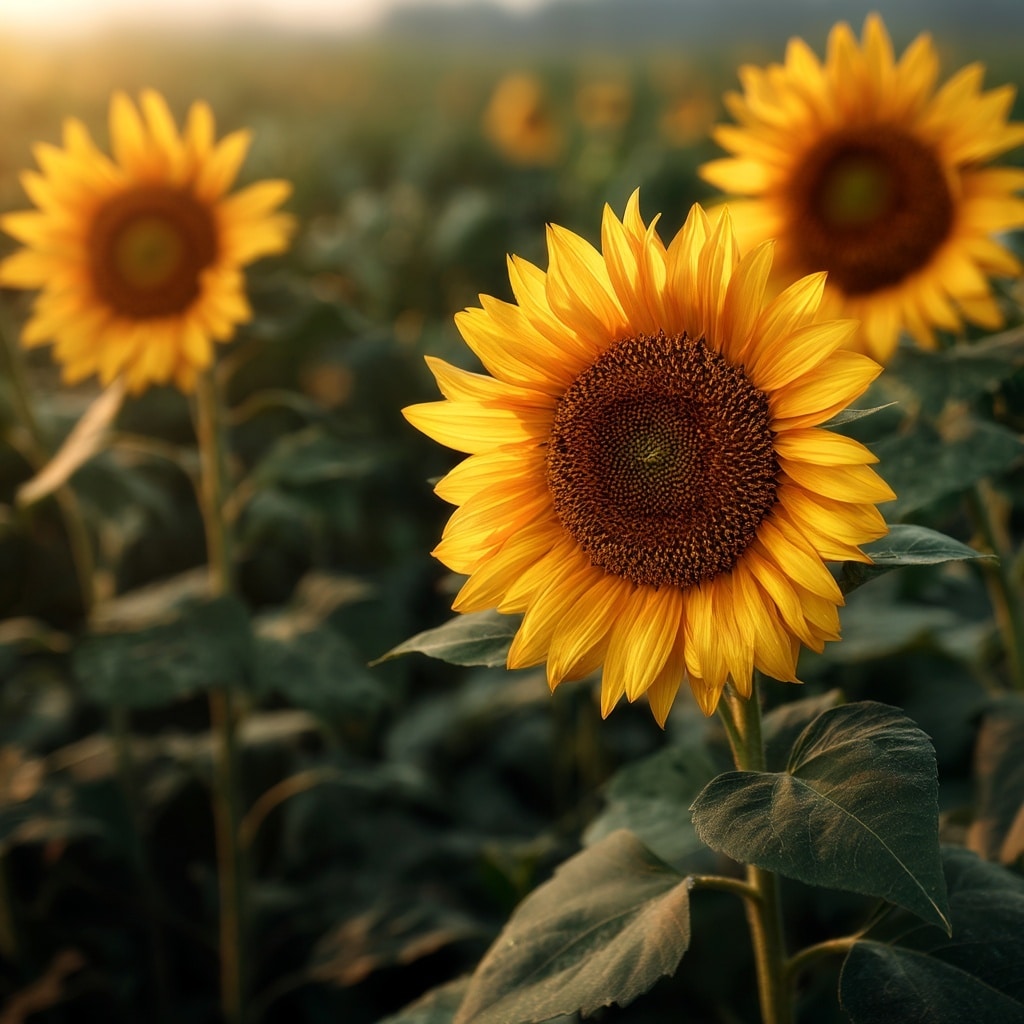
Towering, bright, and cheerful, sunflowers are among the most recognizable plants in the world. With golden petals and a tendency to follow the sun, these giants of the garden bring joy wherever they grow. But sunflowers are more than just pretty faces—they also offer nutritional value and a powerful symbol of vitality and optimism.
Background and Significance
Native to North America, sunflowers were cultivated by Indigenous peoples for food, oil, and dye long before they became ornamental favorites. The name Helianthus comes from the Greek words for sun (helios) and flower (anthos), referencing the plant’s unique ability to track the sun—a trait called heliotropism. Today, they’re celebrated in everything from art (thanks, Van Gogh) to agriculture.
How to Care for Sunflowers
Sunflowers are relatively easy to grow, making them a great choice for beginners and children. Just give them room to shine—literally and figuratively.
🌤️ Sunlight Needs
- As their name suggests, sunflowers need full sun—6 to 8 hours daily is essential.
- Inadequate sunlight leads to leggy stems and small flower heads.
🌱 Soil and Planting
- Sow seeds directly outdoors after the danger of frost has passed.
- Choose well-draining, loose soil with a pH between 6.0 and 7.5.
- Add compost before planting to support healthy growth.
- Space plants 12–24 inches apart, depending on the variety.
💧 Watering Tips
- Keep soil evenly moist during germination and early growth.
- Once established, sunflowers are moderately drought-tolerant but will produce larger blooms with regular watering.
- Water deeply to encourage deep root systems.
🌿 Fertilizing for Growth
- Use a balanced fertilizer early in the season to boost height and flower production.
- Avoid high-nitrogen feeds, which encourage foliage over flowers.
🌻 Supporting Tall Varieties
- Some sunflowers can reach over 10 feet tall!
- Stake tall plants to prevent bending in strong winds.
- Plant in sheltered locations if you’re in a windy area.
🐦 Pests and Protection
- Birds and squirrels love sunflower seeds—cover heads with mesh bags if you plan to harvest.
- Aphids and powdery mildew can occasionally appear. Ensure good airflow and remove infected leaves promptly.
Why They’re Famous
Sunflowers aren’t just stunning—they’re nutritional powerhouses (thanks to their seeds), agricultural staples, and cultural icons. From backyard plots to vast sunflower fields in France and Ukraine, they remain a symbol of energy, joy, and resilience.
Lavender
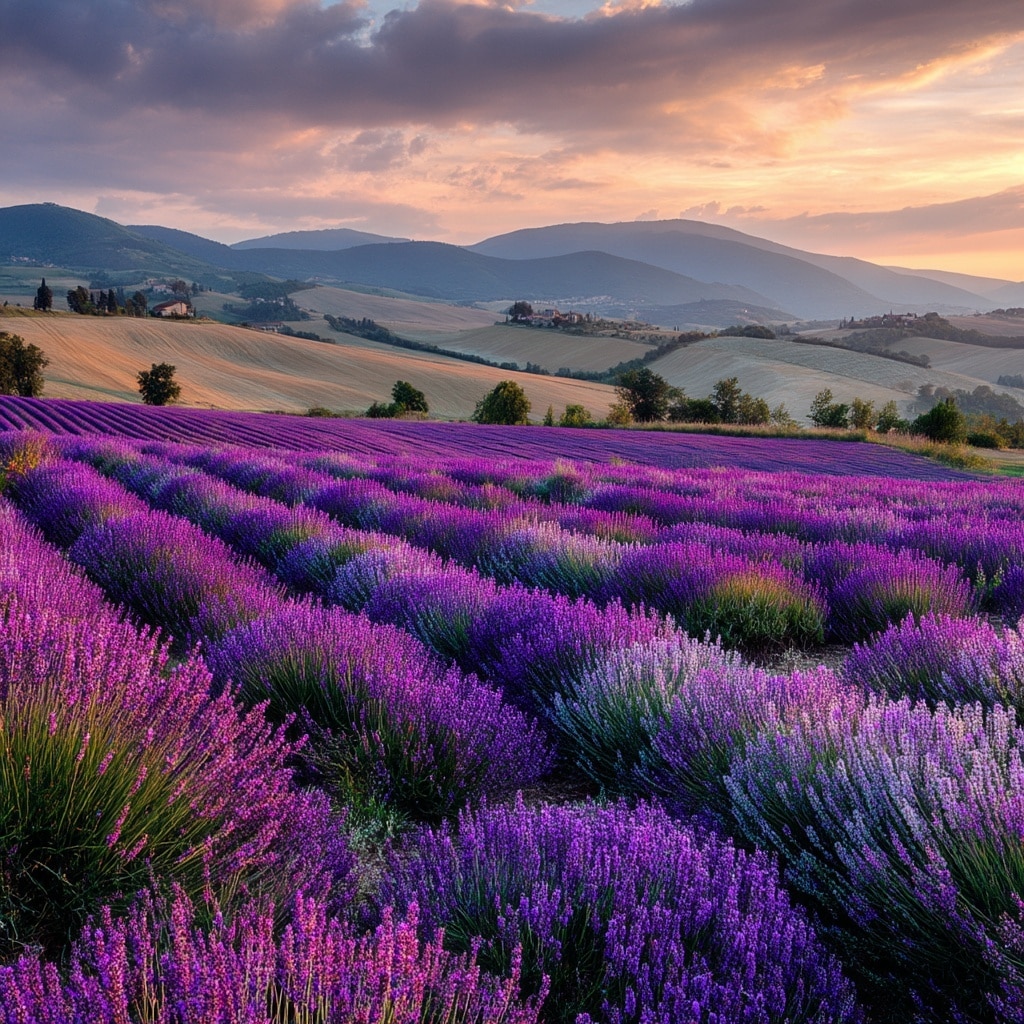
Fragrant, resilient, and striking in bloom, lavender brings a calming presence to any garden. Its soft purple flowers and silvery foliage aren’t just beautiful—they’re also incredibly useful. From herbal teas to essential oils, lavender is a multi-functional plant that’s as practical as it is pretty.
Background and Significance
Native to the Mediterranean, lavender (Lavandula) has been cherished for centuries for its fragrance, medicinal properties, and ornamental value. It’s a favorite in pollinator gardens, herb borders, and cottage landscapes. Used in everything from cosmetics to cuisine, lavender also holds symbolic meaning—representing purity, tranquility, and devotion.
How to Care for Lavender
Lavender is a sun-lover that thrives in dry, open spaces. Once established, it asks for very little—making it ideal for low-maintenance gardening.
🌤️ Sunlight Needs
- Lavender needs at least 6 hours of direct sunlight per day—more is even better.
- Inadequate sun leads to weak stems and reduced blooming.
🪨 Soil and Drainage
- Sharp drainage is non-negotiable. Lavender hates soggy roots.
- Grow it in sandy or gravelly soil with a slightly alkaline pH (7.0–7.5).
- If you’re working with clay, plant in raised beds or amend the soil with grit or coarse sand.
💧 Watering Tips
- Water young plants regularly until they’re established.
- Once mature, allow the soil to dry between waterings—lavender is highly drought-tolerant.
- Avoid overwatering, especially in humid climates.
🌿 Fertilization
- Lavender typically doesn’t need much feeding.
- If desired, apply a light compost dressing in early spring, but avoid nitrogen-rich fertilizers that promote leggy growth.
✂️ Pruning for Shape and Health
- Prune after flowering to maintain a tidy, compact form.
- Cut back by about one-third, but avoid cutting into the woody base.
- Annual pruning helps prevent the plant from becoming woody and sparse.
🐛 Pests and Problems
- Lavender is generally pest- and deer-resistant.
- Overly wet conditions may lead to root rot or fungal issues—always prioritize airflow and drainage.
Why They’re Famous
Lavender is beloved for its soothing scent, resilience, and versatility. Whether you’re making sachets, attracting bees, or simply enjoying the beauty of a purple bloom swaying in the breeze, lavender brings a sensory and emotional richness that few plants can match.
Bonsai
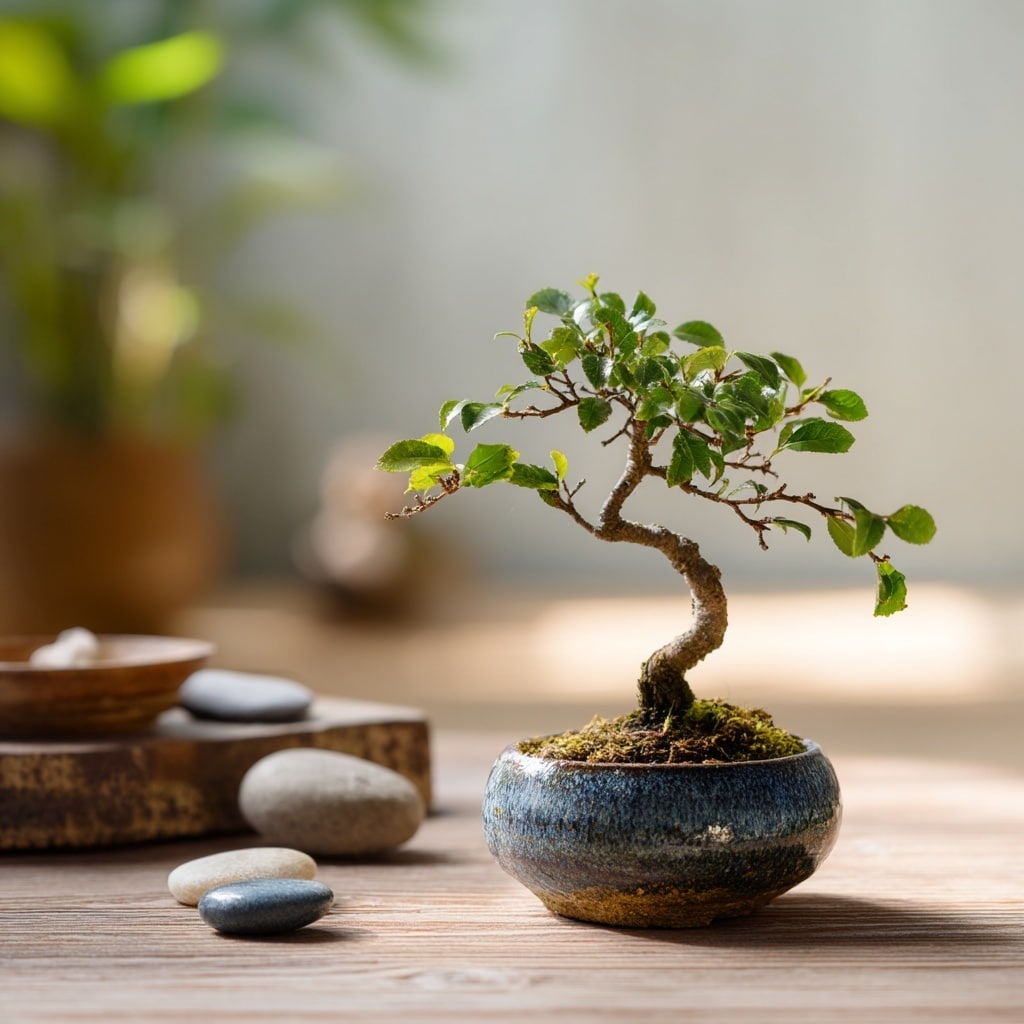
Bonsai isn’t just a plant—it’s a living piece of art. These miniature trees, carefully shaped and maintained over years or even decades, are as much about personal expression as they are about horticulture. Cultivating a bonsai is an exercise in patience, mindfulness, and respect for nature’s form.
Background and Significance
Originating in China and refined in Japan, bonsai translates to “planted in a container.” It’s a traditional practice of training trees to grow in miniature form while maintaining the natural look of full-sized trees. Bonsai symbolizes harmony, balance, and simplicity. Each tree tells a story, shaped slowly by the hands of its keeper.
How to Care for Bonsai
Caring for a bonsai tree is about attention to detail and routine care. Different tree species require specific environments, but the following care principles apply broadly.
🌤️ Light and Environment
- Most bonsai trees need bright, indirect light—some, like junipers, prefer outdoor conditions.
- Indoor bonsai (like Ficus) should be placed near a sunny window but protected from direct midday sun.
- Ensure good air circulation, especially if grown indoors.
🌱 Soil and Containers
- Use bonsai-specific soil, often a mix of akadama, pumice, and lava rock—this ensures excellent drainage and root oxygenation.
- Bonsai pots are shallow to restrict growth and enhance the aesthetic.
- Repot every 2–3 years to refresh soil and prune roots.
💧 Watering with Care
- Water when the topsoil begins to dry out—daily checks are essential, especially in summer.
- Water thoroughly until it drains from the pot’s holes.
- Never let the roots dry completely or sit in standing water.
✂️ Pruning and Shaping
- Structural pruning maintains the tree’s miniature form. Trim excess shoots and branches that disrupt balance.
- Wiring allows shaping of branches over time—be gentle and check frequently to avoid cutting into the bark.
- Root pruning is equally important and should be done during repotting.
🌿 Fertilization
- Bonsai trees require consistent but light feeding.
- Use a balanced, slow-release fertilizer during the growing season (spring through early autumn).
- Cut back feeding in winter when growth slows.
🪴 Indoor vs. Outdoor Care
- Tropical bonsai like Ficus can be grown indoors year-round.
- Temperate species like juniper or maple need a winter dormancy and should be kept outdoors with protection from extreme cold.
Why They’re Famous
Bonsai trees are admired for their aesthetic grace, symbolism, and meditative care process. Each tree reflects years of subtle work, creative intention, and the gardener’s relationship with nature. More than just plants, bonsai are a lifelong journey.
Bamboo

Bamboo is a plant of paradox—both grass and tree-like, fast-growing yet calming, delicate in appearance yet incredibly strong. Its upright canes and lush green leaves bring structure and serenity to gardens, while its cultural symbolism speaks of flexibility, strength, and resilience.
Background and Significance
Native to Asia, bamboo has been used for millennia in construction, food, and art. In Chinese culture, it represents upright character and humility; in Japan, it’s associated with purity and protection. Its rapid growth and versatility have earned it global admiration—not just in forests and farms, but also in urban landscapes and minimalist interiors.
How to Care for Bamboo
Bamboo can be incredibly rewarding when planted thoughtfully. Some types spread aggressively, so planning and containment are key to a harmonious bamboo experience.
🌤️ Light and Position
- Most bamboo species thrive in full to partial sun, with at least 4–6 hours of direct sunlight daily.
- Some smaller or more ornamental varieties tolerate light shade.
- Indoor bamboo (like “Lucky Bamboo”) prefers bright, filtered light, not direct sun.
🌱 Soil and Watering
- Bamboo prefers moist, well-draining soil rich in organic matter.
- Keep the root zone damp during the first year—after that, mature bamboo is fairly drought-tolerant.
- Avoid letting soil dry out completely, especially in heat.
🪴 Container Growth and Control
- To prevent bamboo from taking over your garden, choose clumping varieties or use root barriers for running types.
- Bamboo grows well in large containers, especially for patios or indoor decor.
- Container-grown bamboo needs regular watering and annual fertilizing.
🌿 Fertilizing Bamboo
- Apply a nitrogen-rich fertilizer in spring to promote fast, leafy growth.
- Compost and mulch also help retain moisture and boost soil nutrients.
🌾 Growth and Maintenance
- Some bamboo varieties can grow up to 3 feet in 24 hours—regular thinning or pruning is often needed.
- Cut older, dead canes at the base to promote airflow and encourage new growth.
Why They’re Famous
From serene Zen gardens to towering tropical screens, bamboo is valued for its aesthetic simplicity, rapid growth, and symbolic depth. Whether you’re crafting a natural fence, decorating your balcony, or embracing Eastern garden design, bamboo offers unmatched elegance and utility.
Cacti
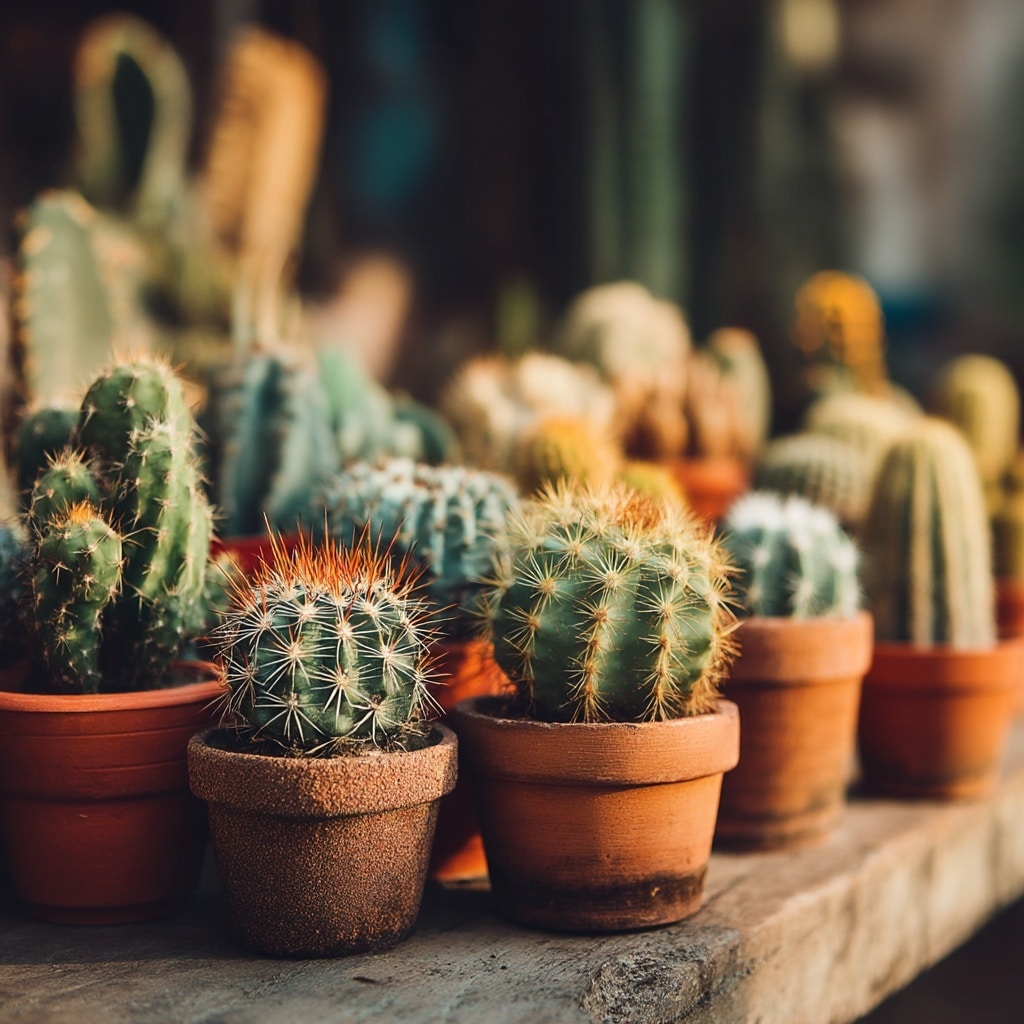
Cacti are the ultimate survivors—thriving in some of the harshest environments on Earth. With their bold forms, spines, and occasional bursts of dazzling blooms, these plants bring both structure and personality to gardens and indoor spaces alike. Their low-maintenance nature makes them a favorite for beginners and collectors alike.
Background and Significance
Belonging to the family Cactaceae, cacti are native to the Americas, especially arid regions like deserts and high plains. Their unique ability to store water, defend themselves with spines, and endure intense heat and drought has made them a symbol of resilience and endurance. From the iconic Saguaro of the American Southwest to tiny, flowering globes on windowsills, cacti have earned their fame through adaptability and visual intrigue.
How to Care for Cacti
Despite their rugged looks, cacti need the right environment to thrive—especially when grown indoors. The key is to mimic their native desert conditions.
🌤️ Sunlight Needs
- Most cacti love bright, direct sunlight for at least 6 hours per day.
- South- or west-facing windows are ideal for indoor plants.
- If light is limited, consider using a grow light to supplement.
🪨 Soil and Drainage
- Use a cactus-specific mix that includes sand, pumice, or perlite to ensure quick drainage.
- Never plant cacti in standard potting soil—it holds too much moisture and can lead to rot.
💧 Watering Strategy
- Water deeply but infrequently. Allow soil to dry completely between waterings.
- In warm months, water every 2–4 weeks; in winter, reduce to once a month or less.
- Always use pots with drainage holes to prevent standing water.
🌡️ Temperature and Environment
- Cacti prefer warm temperatures, ideally 65–85°F (18–29°C).
- Some varieties can tolerate cooler nights but avoid frost unless it’s a hardy species.
- Ensure good air circulation to discourage mold and mildew.
🌿 Fertilization
- During the growing season (spring/summer), feed monthly with a low-nitrogen fertilizer (e.g., 2-7-7).
- Skip feeding during dormancy in winter.
🐛 Common Issues
- Overwatering is the most common killer—when in doubt, wait to water.
- Watch for pests like mealybugs or spider mites, especially indoors.
- Use neem oil or rubbing alcohol on a cotton swab to treat infestations.
Why They’re Famous
Cacti are iconic for a reason. They symbolize adaptation, protection, and inner strength. Whether towering in a desert landscape or perched in a minimalist home office, cacti command attention with their sculptural forms and fierce independence.
Lotus
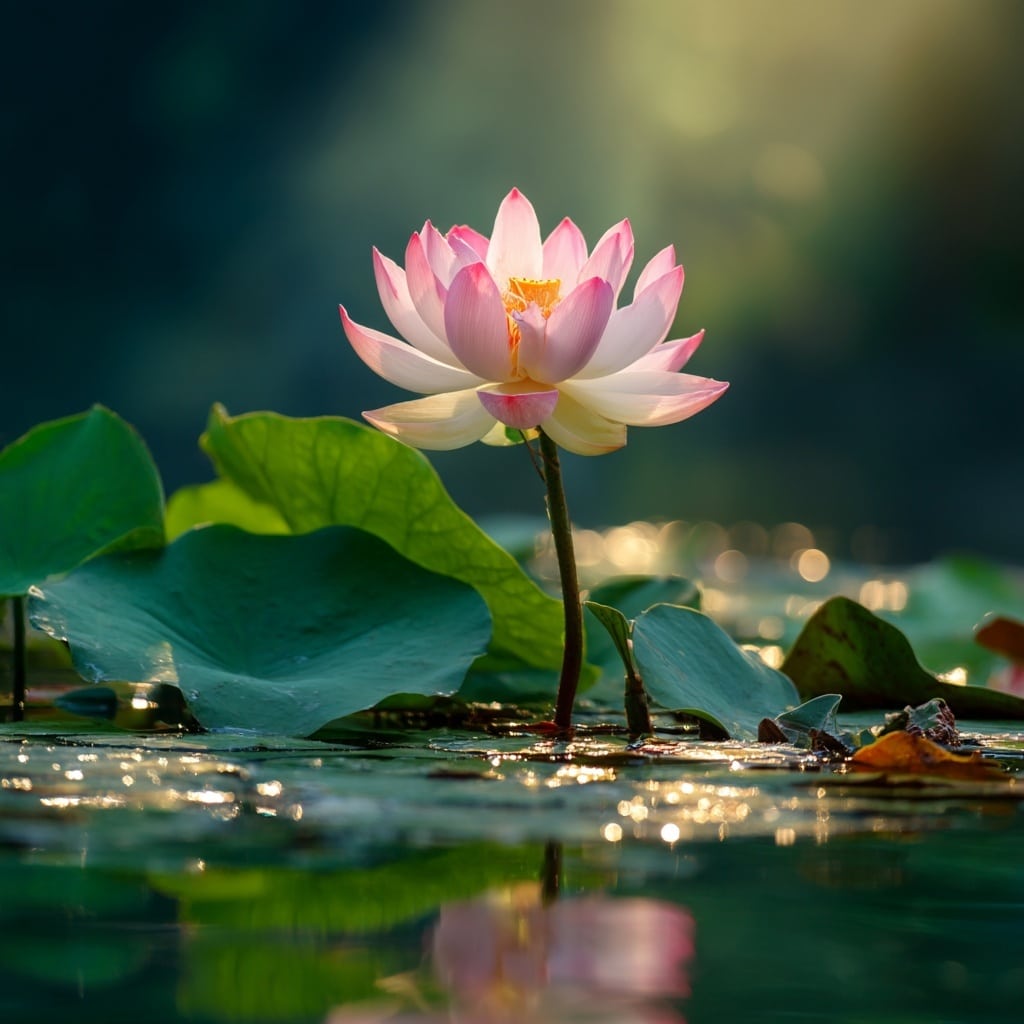
The lotus is a plant of elegance and symbolism. Rising from still, muddy water to bloom in brilliant purity, it has captivated cultures for thousands of years. More than just a striking aquatic flower, the lotus represents renewal, enlightenment, and grace. Whether featured in temple ponds or ornamental water gardens, its serene beauty is unmatched.
Background and Significance
Native to Asia, particularly India and China, the lotus (Nelumbo nucifera) holds deep religious and philosophical importance. In Buddhism and Hinduism, it symbolizes spiritual awakening, purity, and rebirth, often depicted as the throne of gods and enlightened beings. Beyond symbolism, lotus plants are admired for their large, fragrant blooms and remarkable ability to emerge clean from murky waters—a trait that adds to their metaphorical power.
How to Care for Lotus
While the lotus might seem delicate, it’s surprisingly hardy when its basic growing conditions are met. The key is warm temperatures, still water, and sunlight.
🌤️ Sunlight Requirements
- Lotus plants need full sun, at least 6 hours daily.
- Insufficient sunlight leads to stunted growth and weak flowering.
💧 Water and Environment
- Lotus grows best in still, shallow water—ideal for ponds, tubs, or water gardens.
- Keep water depth between 2–12 inches above the soil level, depending on the plant’s size and maturity.
- Avoid moving water or fountains near the plant, as lotus prefers calm conditions.
🪴 Planting and Soil
- Plant lotus tubers in wide, shallow containers filled with heavy clay soil or aquatic plant mix.
- Do not use potting mix—it floats and breaks down in water.
- Gently press the tuber into the soil, with growth tips angled upward, and cover lightly.
🌡️ Temperature and Dormancy
- Lotus thrives in warm temperatures: 70–90°F (21–32°C) water is ideal.
- In colder climates, bring potted lotus indoors or sink containers deeper in ponds to protect tubers from frost.
- Lotus naturally goes dormant in winter—cut back old growth and store properly if needed.
🌿 Fertilizing
- Use slow-release aquatic fertilizer tablets inserted into the soil monthly during the growing season.
- Avoid fertilizing when the plant is dormant.
🌸 Maintenance and Tips
- Remove yellowing leaves and spent blooms to keep the water clean and encourage new growth.
- Divide tubers every few years to prevent overcrowding and rejuvenate the plant.
Why They’re Famous
Lotus plants are more than ornamental—they’re symbols of purity, peace, and transformation. Their ability to flourish in muddy water and still produce pristine blooms is why they’re revered not just in gardens but in hearts and philosophies around the world.
Carnivorous Plants
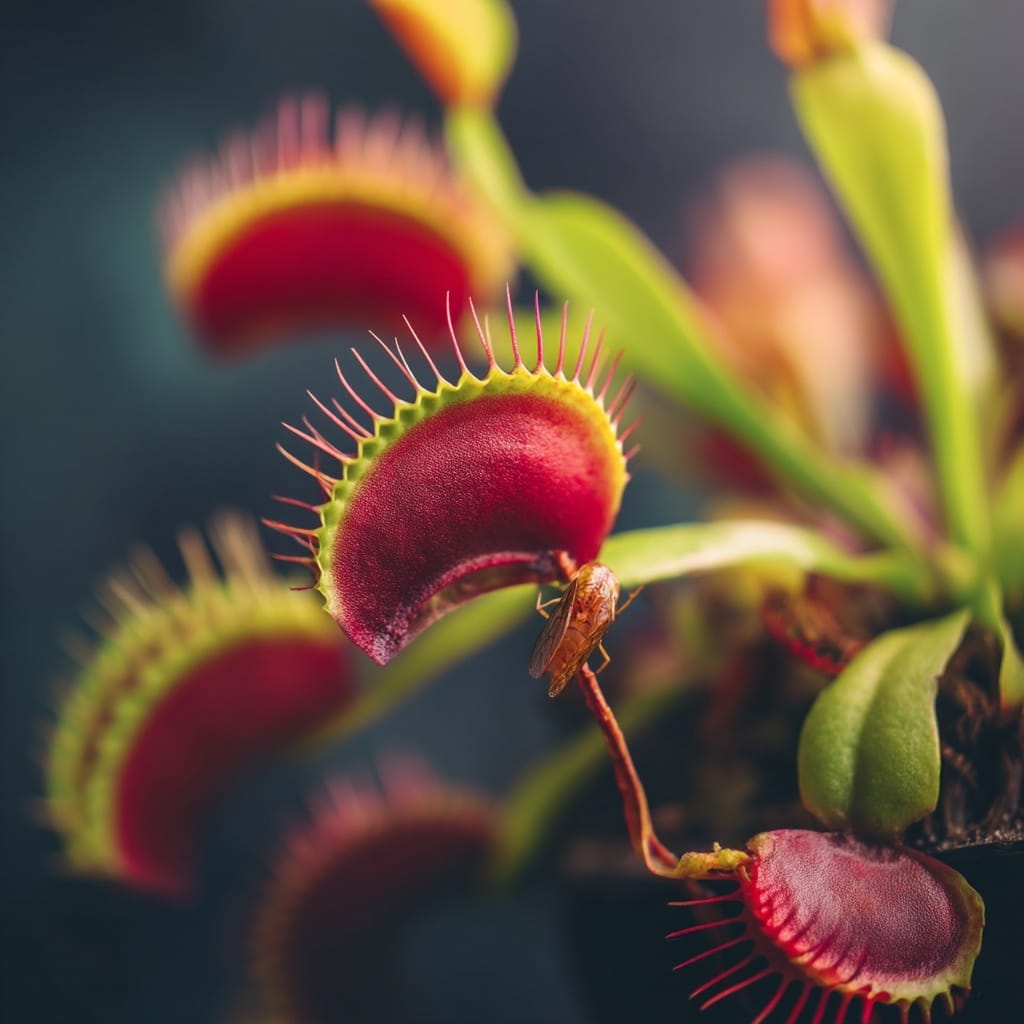
Mysterious, otherworldly, and strangely captivating, carnivorous plants defy the norm. Unlike most plants that absorb nutrients solely from soil, these unique species have evolved to trap and digest insects to supplement their diet—an adaptation to the nutrient-poor environments they call home. Their unusual forms and feeding behaviors make them both conversation starters and science marvels.
Background and Significance
Carnivorous plants have intrigued scientists and gardeners alike since the days of Charles Darwin. Found in bogs, swamps, and other low-nutrient habitats, these plants evolved to survive by catching prey. Notable types include the Venus Flytrap (Dionaea muscipula), Pitcher Plants (Sarracenia and Nepenthes), and Sundews (Drosera).
Their unique mechanisms—snapping jaws, sticky traps, and pitfall traps—make them fascinating specimens for botanical collections and educational displays.
How to Care for Carnivorous Plants
These plants are highly specialized, but with the right conditions, they can thrive indoors or in a controlled outdoor environment.
🌤️ Light Requirements
- Most species need bright light or partial direct sunlight.
- Venus Flytraps and many Pitcher Plants thrive with at least 4–6 hours of sun per day.
- For indoor growers, use a grow light if natural light is limited.
💧 Water and Humidity
- Always use distilled water or rainwater—tap water contains minerals that can kill the plant.
- Keep the soil constantly moist but not waterlogged.
- Maintain high humidity, especially for tropical species. Sundews and Nepenthes benefit from terrariums or humidity trays.
🌱 Soil Needs
- Use a low-nutrient mix, typically 50/50 sphagnum peat moss and perlite or silica sand.
- Never use regular potting soil or fertilizer—it can damage or kill the plant.
🪱 Feeding Habits
- Outdoors, they’ll catch their own food.
- Indoors, offer an occasional insect (live or freeze-dried) once every few weeks.
- Do not feed meat or dairy—this will rot and harm the plant.
- Avoid triggering traps for fun—it wastes the plant’s energy.
❄️ Dormancy Period
- Some species like Venus Flytraps and North American Pitcher Plants require a cool winter dormancy.
- During this period, reduce watering, and keep the plant in a cooler spot (around 35–50°F / 2–10°C).
- Don’t throw the plant away—it’s just resting!
Why They’re Famous
No other plants capture the imagination quite like these. Their ability to hunt, their alien beauty, and their evolutionary brilliance make carnivorous plants icons of the botanical world. Whether you’re a science lover, a curious gardener, or just want something different on your windowsill, they offer a rewarding and educational experience.
Bringing It All Together
Whether you’re nurturing the dramatic elegance of orchids, tending to cheerful sunflowers, or shaping a miniature bonsai masterpiece, each famous plant offers a unique blend of beauty, symbolism, and reward. By understanding their specific needs—from sunlight and soil to pruning and watering—you can enjoy a more fulfilling gardening experience, no matter your skill level.
When adding these legendary plants to your collection, remember:
- Match the plant to your environment—not every species thrives indoors or in all climates.
- Start with a few favorites to avoid overwhelm. Lavender, cacti, or sunflowers are beginner-friendly options.
- Use observation as a tool—plants often “speak” through their leaves, growth rate, or flowering patterns.
As your garden grows, so will your confidence. Every new leaf, bud, or bloom is a reminder of the small, daily effort that makes all the difference.
🌱 Looking for more plant inspiration? Consider adding companion plants for roses or drought-tolerant companions for lavender. Explore our other gardening guides here to build a thriving, beautiful space—one plant at a time.
Conclusion
Growing the world’s most famous plants isn’t just about beauty—it’s about connection. Connection to history, to nature, and to the small rituals that bring life into our homes and hearts. Whether you’re planting for peace, for food, or for color, the right plant—given the right care—will reward you endlessly.



